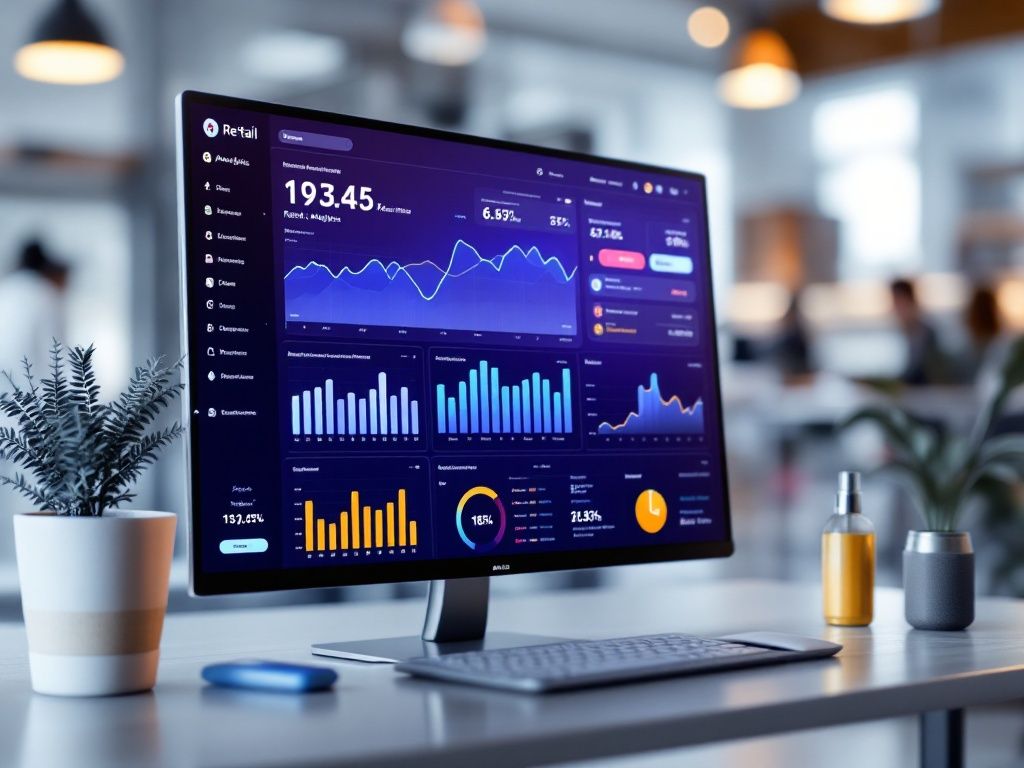
Fashion retail analytics tools - Revolutionizing the industry with data-driven insights
Ever wonder how fashion brands seem to anticipate your style cravings? It's not magic, but data. Savvy brands are leveraging retail analytics software, a game-changer that helps them predict trends and cater to your evolving tastes.
Understanding retail analytics software in fashion
Think of it as a super-powered crystal ball, but instead of gazing into smoke, it's analyzing tons of data – sales figures, online habits, social buzz, and even weather patterns – to uncover trends humans would likely miss. This helps them know, for example, the perfect number of red dresses to stock for Valentine's Day.
It's not just about trends; these tools also help brands:
- Determine which items sell well and which don't.
- Design store layouts to enhance browsing (and buying).
- Speed up the process from design to your closet.
- Encourage repeat visits with custom loyalty programs.
- Promote sustainability by reducing waste.
As the fashion world evolves at top speed, retail analytics software becomes essential for brands aiming to stay relevant.
By using data, retailers gain valuable insights to create styles you'll love, ensure availability, and provide an experience that keeps you coming back. It's like having a personal stylist working behind the scenes! Now that you have a handle on the what and why, let's dive into the specifics.
Key features of fashion retail analytics tools
Now that you know the basics, let's explore the features making these tools so popular. They're loaded with capabilities that would impress even the most stylish influencer.
Real-time data analysis gives retailers instant updates on sales, stock levels, and customer behavior. It's like having eyes everywhere, helping brands respond quickly to emerging opportunities or issues before they become problems.
Predictive analytics serves as the fashion world's crystal ball. By analyzing past data patterns and current trends, these tools forecast future demand with remarkable accuracy. This helps brands stock up on what customers will want before they even realize it themselves.
Customer segmentation tools help retailers group shoppers by style preferences, shopping habits, and spending patterns. This enables brands to tailor their offerings and communications to specific customer groups, ensuring shoppers see more of what they love.
Trend forecasting capabilities constantly scan social media, search data, and consumer behavior to spot the next big thing before it hits the mainstream. This gives brands crucial lead time to adjust their designs and inventory accordingly.
Advanced pricing engines analyze competitor prices, demand patterns, and customer willingness to pay, resulting in pricing strategies that balance competitiveness with profitability.
Inventory management features monitor stock levels, sales rates, and product performance across different locations or channels. This helps prevent both overstock situations and disappointed customers looking for sold-out items.
In-store analytics use computer vision and sensors to analyze how customers interact with products in physical retail environments. This provides insights into shopper behavior that were previously impossible to capture systematically.
Omnichannel performance tracking gives brands a bird's-eye view of how customers shop across different touchpoints, allowing them to create seamless experiences whether you're browsing online or in-store.
Supply chain analytics track supplier performance, including delivery times and quality metrics, helping brands maintain consistent product standards and minimize delays.
User-friendly dashboards make all these insights accessible to everyone from designers to store managers, creating a data-informed culture throughout the organization.
By leveraging these capabilities, fashion retailers can make smarter decisions, improve operational efficiency, and ultimately provide the styles customers want, when they want them. So, with these features in mind, what exactly can these solutions do for a fashion brand's bottom line?
Benefits of implementing retail analytics solutions in fashion
The benefits of retail analytics extend far beyond just having more data. Let's explore how these tools can transform a fashion brand from outdated to trend-setting.
Better decision-making sits at the core of analytics adoption. Fashion brands face countless choices about what to stock, how much to order, and how to price items. Retail analytics solutions provide data-driven guidance on these decisions, reducing reliance on guesswork and intuition.
Improved inventory management ensures customers can find their favorite styles in stock. By balancing inventory levels with projected demand, brands can avoid both excess stock that leads to markdowns and stockouts that disappoint customers.
Personalized shopping experiences create deeper connections with customers. By understanding individual preferences through purchase and browsing history, brands can recommend products customers will love and create a sense that the brand truly understands them. This personalization leads to higher customer satisfaction and increased sales.
Competitive advantage comes from identifying emerging trends early. Fashion analytics tools help brands stay ahead of the curve by spotting patterns before they become mainstream, ensuring they offer the hottest styles before competitors.
Supply chain efficiency improves when brands have better visibility into their entire operation. Analytics tools streamline processes from production to delivery, reducing delays and getting products to market faster.
Omnichannel consistency becomes easier to maintain when brands can track performance across all channels. This creates a unified experience whether customers are shopping online, via mobile, or in physical stores.
Reduced markdowns result from better demand forecasting. By more accurately predicting what will sell, brands avoid overstocking items that end up on the clearance rack, protecting their margins and brand positioning.
Enhanced customer retention comes from understanding shopping patterns and preferences. Brands can identify when customers might switch to a competitor and offer personalized incentives to keep them loyal.
In short, retail analytics solutions help fashion brands become smarter, more efficient, and more customer-centric. This technological makeover results in better products, smoother shopping experiences, and more satisfied customers – a combination that drives sustainable growth. But which platforms are leading this revolution?
Top retail analytics platforms for fashion businesses
Several specialized platforms have emerged to address the unique analytics needs of fashion retailers. Let's examine some of the key players in this space.
EDITED stands out as a versatile tool for retail intelligence, offering competitive analysis and pricing strategy features specifically tailored to fashion brands. It helps retailers benchmark their assortments, pricing, and discounting against competitors.
Woven Insights specializes in transforming complex retail data into actionable insights. Known for its user-friendly interface and affordable pricing structure, it has become particularly popular among emerging brands looking to compete with established players.
Stylumia harnesses AI to predict fashion trends with remarkable accuracy. Its features include trend forecasting, design prediction, and market positioning analysis, making it a powerful tool for brands that want to stay ahead of rapidly changing consumer preferences.
Heuritech takes a unique approach by analyzing social media imagery to identify emerging styles and trends. Its visual recognition technology helps brands spot micro-trends before they hit the mainstream market.
WGSN focuses on long-term trend prediction, analyzing everything from consumer behavior to product design. Its comprehensive forecasts help brands develop products that will resonate with consumers seasons in advance.
With these platforms, fashion brands can:
- Predict which styles will become popular
- Maintain optimal inventory levels across locations
- Develop targeted marketing campaigns for specific customer segments
- Set competitive yet profitable prices
- Identify emerging trends before competitors
As fashion continues to evolve at an accelerating pace, these analytics platforms are becoming essential tools for brands trying to keep up with changing consumer preferences while maintaining operational efficiency.
The next time you find the perfect outfit or notice a fresh trend in stores, remember that sophisticated analytics platforms might be working behind the scenes to bring that fashion magic to life. But how does a fashion business successfully implement these powerful tools?
Implementing fashion analytics - Best practices and challenges
Successfully introducing analytics tools into a fashion business requires careful planning and execution. Let's explore both the best practices and common challenges in this journey.
Best Practices
Data quality management is fundamental – ensuring data is accurate, complete, and consistent across systems. Without reliable data, even the most sophisticated analytics tools will produce misleading insights.
Cross-functional collaboration maximizes the value of analytics. When merchandising, design, marketing, and operations teams work together around shared data, they create a coordinated approach that amplifies results.
Real-time capabilities are essential in fashion's fast-paced environment. Having up-to-the-minute data on sales, inventory, and customer behavior allows brands to respond quickly to emerging opportunities or issues.
Predictive modeling helps brands anticipate trends and customer preferences before they become obvious. This forward-looking approach is particularly valuable in fashion, where being ahead of trends can dramatically impact success.
Customized dashboards should be tailored to different roles within the organization. Designers need different insights than store managers or executives, and interfaces should reflect these varying needs.
Continuous learning and improvement keep analytics systems relevant. Regular updates to models and approaches ensure they remain aligned with evolving business goals and market conditions.
Common Challenges
Data integration difficulties often arise when trying to connect disparate systems. Bringing together data from e-commerce platforms, in-store POS systems, social media, and other sources requires technical expertise and careful planning.
Talent gaps present obstacles for many fashion retailers. Finding professionals who understand both fashion retail and data science is challenging due to high demand and specialized skill requirements.
Balancing data-driven decisions with creative intuition requires finesse. Fashion is both art and science, and successful brands find ways to complement creative vision with analytical insights rather than replacing one with the other.
Change management issues emerge when introducing new technology. Gaining organization-wide acceptance for analytics-driven approaches can be difficult, particularly in companies with strong traditional merchandising cultures.
Privacy concerns require careful navigation. As brands collect and leverage more customer data, they must ensure compliance with regulations while maintaining consumer trust.
Technology selection presents another challenge. With numerous platforms available, choosing the right tools for specific business needs requires thorough evaluation and clear alignment with strategic goals.
Overcoming these challenges might be difficult, but fashion brands that successfully implement analytics gain significant advantages. By following best practices and addressing common pitfalls, retailers can transform data into their most valuable asset. As technology continues to evolve, what's on the horizon for fashion retail analytics?
Future trends in fashion retail analytics
The fashion retail analytics landscape continues to evolve rapidly, with several emerging trends poised to reshape how brands understand and engage with consumers.
AI and machine learning capabilities will become increasingly sophisticated. These systems will predict demand with greater accuracy, personalize shopping experiences at an individual level, and make autonomous decisions about inventory allocation and pricing.
Visual recognition technology will transform how consumers discover products. Shoppers will be able to photograph items they like and instantly find where to purchase them. For retailers, this technology will improve product categorization and provide insights into which visual elements drive consumer interest.
Internet of Things (IoT) devices will bring new dimensions to retail analytics. Smart fitting rooms, RFID tags, and connected displays will generate rich data about how customers interact with products in physical spaces.
Sustainability metrics will gain prominence as consumers increasingly demand ethical and environmentally responsible fashion. Analytics tools will help brands track their environmental impact, reduce waste, and communicate these efforts authentically to customers.
Voice analytics may emerge as a new data source, analyzing customer service interactions to understand shopper preferences and pain points in ways traditional surveys cannot capture.
Blockchain technology will increase transparency throughout the fashion supply chain. This will allow brands to verify ethical sourcing claims and give consumers the ability to trace garments from production to purchase.
Augmented reality experiences will generate valuable data about consumer preferences. As virtual try-ons and product visualizations become commonplace, brands will gain insights into which styles customers consider but don't purchase.
Cross-channel attribution models will become more sophisticated, helping brands understand complex customer journeys that span social media, online browsing, and in-store shopping.
Ethical data use frameworks will evolve alongside technology. As analytics capabilities grow more powerful, brands will need robust approaches to ensure they use customer data responsibly and transparently.
The future of fashion retail analytics promises even more personalized, efficient, and sustainable shopping experiences. As technology continues to evolve, the brands that thrive will be those that harness these innovations while maintaining their creative vision and authentic connection with customers.
As you step into the future of fashion retail, remember that data-driven insights are no longer a luxury but a necessity for staying competitive and delighting customers. By embracing analytics, fashion brands can create more personalized, sustainable, and efficient experiences that resonate with today's savvy shoppers. So go ahead, embrace the data, and let it guide your fashion journey!




